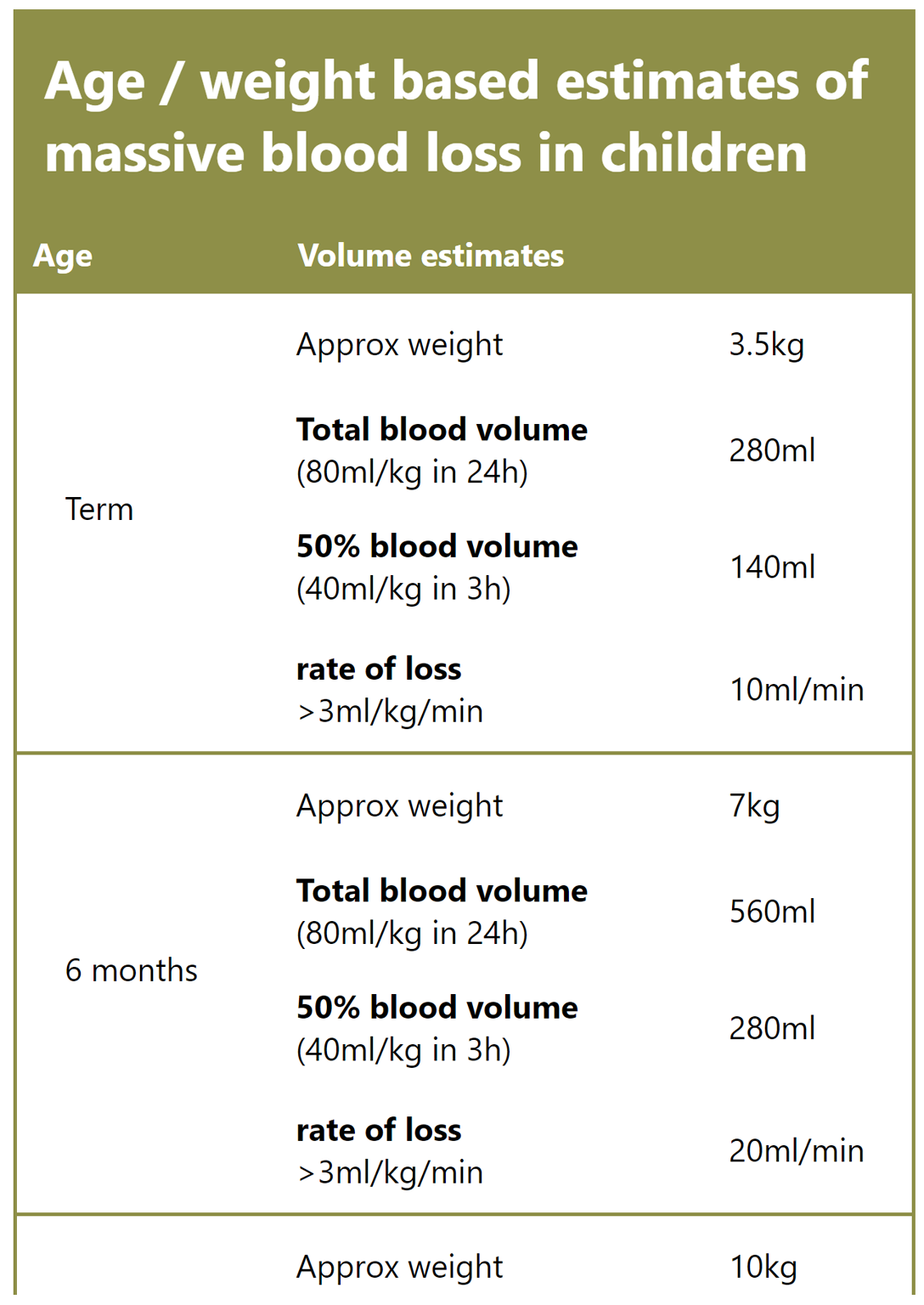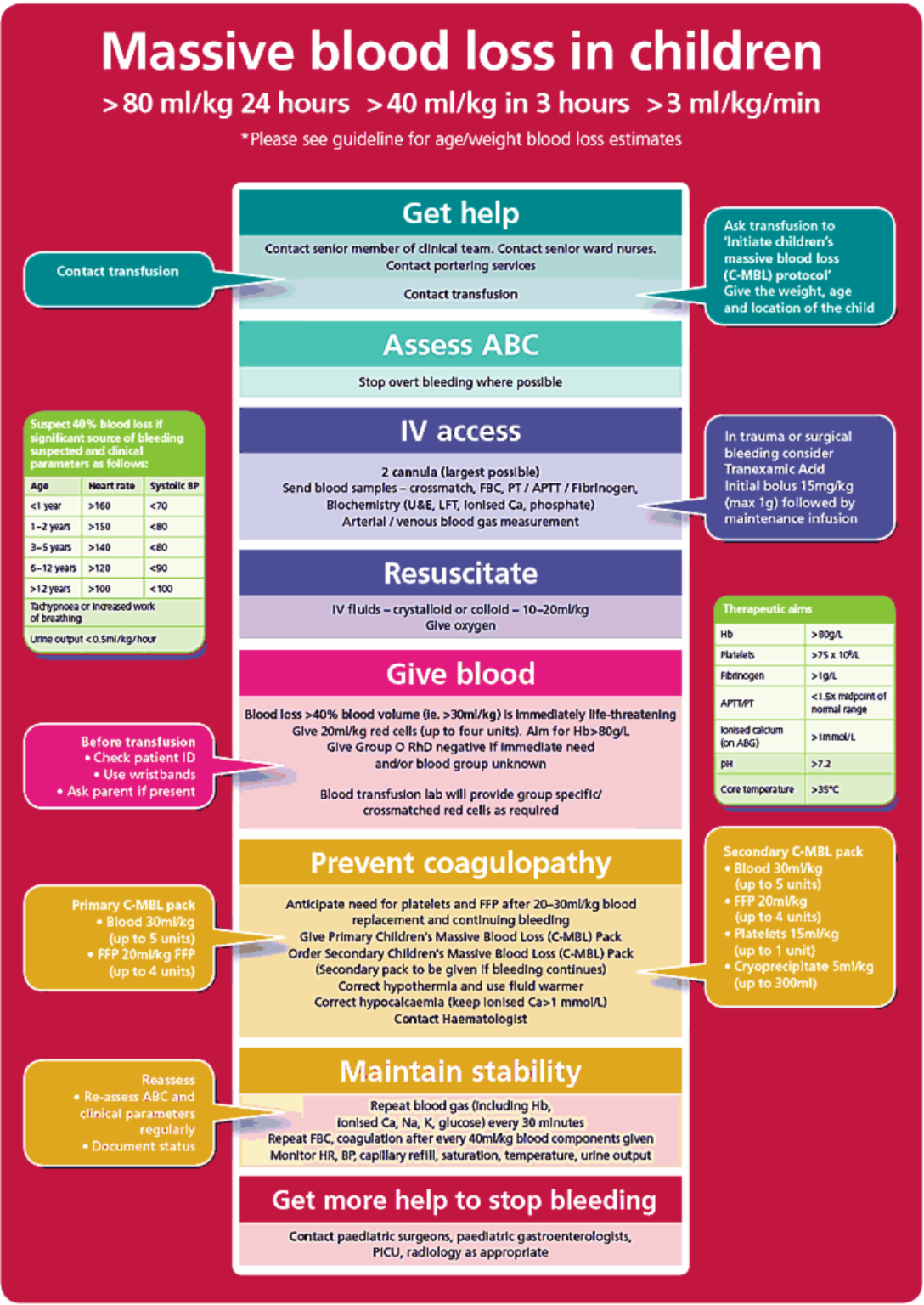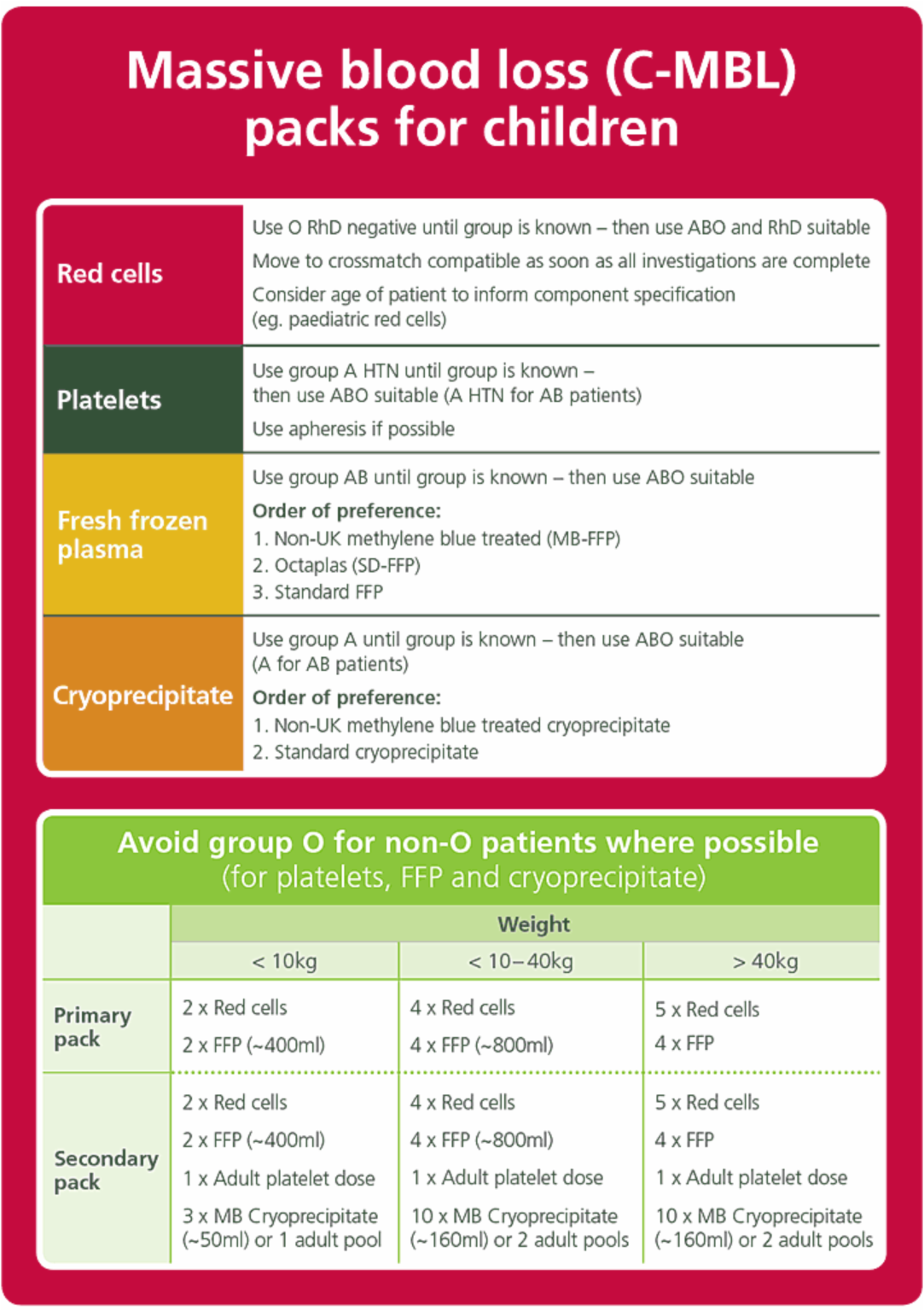Scroll to read the whole document, or click image to select section to scroll to:



Definitions
Massive blood loss in children may be defined as:
- loss of one blood volume in 24 hours (approximately >80ml/kg in those <40kg) or
- loss of 50% blood volume in three hours (approximately 40ml/kg in those <40kg) or
- loss of >3ml/kg/min.
The chart below offers volume estimates for children.
| Age / weight based estimates of massive blood loss in children | ||
| Age | Volume estimates | |
| Approx weight | 3.5kg | |
| Term |
Total blood volume (80ml/kg in 24h) |
280ml |
|
50% blood volume (40ml/kg in 3h) |
140ml | |
|
rate of loss >3ml/kg/min |
10ml/min | |
| Approx weight | 7kg | |
| 6 months |
Total blood volume (80ml/kg in 24h) |
560ml |
|
50% blood volume (40ml/kg in 3h) |
280ml | |
|
rate of loss >3ml/kg/min |
20ml/min | |
| Approx weight | 10kg | |
| 1 year |
Total blood volume (80ml/kg in 24h) |
800ml |
|
50% blood volume (40ml/kg in 3h) |
400ml | |
|
rate of loss >3ml/kg/min |
30ml/min | |
| Approx weight | 20kg | |
| 5 years |
Total blood volume (80ml/kg in 24h) |
1600ml |
|
50% blood volume (40ml/kg in 3h) |
800ml | |
|
rate of loss >3ml/kg/min |
60ml/min | |
| Approx weight | 30kg | |
| 10 years |
Total blood volume (80ml/kg in 24h) |
2400ml |
|
50% blood volume (40ml/kg in 3h) |
1200ml | |
|
rate of loss >3ml/kg/min |
90ml/min | |
| Approx weight | 40kg | |
| 12 years |
Total blood volume (80ml/kg in 24h) |
2800ml* |
|
50% blood volume (40ml/kg in 3h) |
1400ml* | |
|
rate of loss >3ml/kg/min |
100ml/min* | |
| Approx weight | 60kg | |
| 16 years |
Total blood volume (80ml/kg in 24h) |
4200ml* |
|
50% blood volume (40ml/kg in 3h) |
2100ml* | |
|
rate of loss >3ml/kg/min |
150ml/min* | |
* Based on blood volume 70ml/kg in over 12 year old
Massive blood loss in children
> 80ml/kg in 24 hours >40ml/kg in 3 hours >3ml/kg/min
*Please see guideline for age/weight blood loss estimates
Get help
Contact senior member of clinical team. Contact senior ward nurses Contact portering services
Contact Transfusion
Assess ABC
Stop overt bleeding where possible
IV access
2 large cannula (largest possible)
Send blood samples - cross-match, FBC, PT / APTT /
Fibrinogen
Biochemistry (U&E, LFT, ionised
Ca, phosphate)
Arterial / venous blood gas
measurement
Resuscitate
IV warm fluids – crystalloid or colloid
Give
oxygen
Give blood
Blood loss >40% blood volume is immediately
life-threatening
Give 20ml/kg red cells (up to four units).
Aim for Hb>80g/L
Give Group O RhD negative
if immediate need
and/or blood group
unknown
Blood transfusion lab will
provide group specific/
crossmatched red
cells as required
Prevent coagulopathy
Anticipate need for platelets and FFP after
20–30ml/kg blood
replacement and continuing
bleeding
Give Primary Children’s Massive
Blood Loss (C-MBL) Pack
Order Secondary
Children’s Massive Blood Loss (C-MBL) Pack
(Secondary
pack to be given if bleeding continues)
Correct
hypothermia and use fl uid warmer
Correct
hypocalcaemia (keep ionised Ca>1 mmol/L)
Contact
Haematologist
Maintain stability
Repeat blood gas (including Hb,
ionised Ca,
Na, K, glucose) every 30 minutes
Repeat FBC,
coagulation after every 40ml/kg blood components
given
Monitor HR, BP, capillary refill,
saturation, temperature, urine output
Get more help to stop the bleeding
Contact paediatric surgeons, paediatric
gastroenterologists,
PICU, radiology as
appropriate
Massive blood loss (C-MBL)
packs for children
| Red cells |
|
| Platelets |
|
| Fresh frozen plasma |
|
| Fresh frozen plasma |
|
Avoid group O for non-O patients where
possible
(for platelets, FFP and cryoprecipitate)
| Weight | Pack |
| <10kg | Primary pack |
|
2 x Red cells 2 x FFP (~400ml) |
|
| Secondary pack | |
|
2 x Red cells 2 x FFP (~400ml) 1 x Adult platelet dose 3 x MB Cryo-precipitate (~50ml) or 1 adult pool |
|
| 10kg-40kg | Primary pack |
|
4 x Red cells 4 x FFP (~800ml) |
|
| Secondary pack | |
|
4 x Red cells 4 x FFP (~800ml) 1 x Adult platelet dose 10 x MB Cryo-precipitate (~160ml) or 2 adult pools |
|
| >40kg | Primary pack |
|
5 x Red cells 4 x FFP |
|
| Secondary pack | |
|
5 x Red cells 4 x FFP 1 x Adult platelet dose 10 x MB Cryo-precipitate (~160ml) or 2 adult pools |